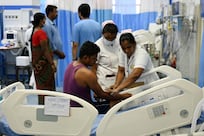This year brought about one of the most sweeping moves yet to safeguard Abu Dhabi’s heritage.
The emirate's Department of Culture and Tourism announced in July that 64 buildings and sites required “immediate and unconditional protection”.
The department’s Modern Heritage Conservation Initiative prioritises maintaining and rehabilitating the buildings according to their designated grade. No demolition applications are allowed.
“It is our civic responsibility to guard this modern heritage,” said Mohamed Khalifa Al Mubarak, chairman of DCT Abu Dhabi.
“Not only because of the value it holds in our collective memory as residents of this emirate but because of the historical testimony it has in telling Abu Dhabi’s story through architectural and urban identity between the traditional past and our aspirations for the future.”
Preserving rich heritage
Prominent buildings such as the old Adnoc headquarters, the Central Bank, Abu Dhabi Chamber of Commerce and the city’s main bus terminal came under the initiative.

But, as the photos in the gallery show, the 64 also include less familiar places – including parks, water tanks, a health complex, one of the early residential towers, and even a cluster of ghaf trees in the city.
These tell the history of Abu Dhabi as well as the more prominent buildings. The Niqa bin Ateej water tank and park in Khalidiyah, for example, ensured vital water supplies for a city massively expanding on the back of the oil boom.
Parks such as Airport Road Park brought greenery to a desert city, allowed families to enjoy downtime and children to delight in its pineapple slides. This park was also home to one of the city’s first fast-food chains, Wimpy, with the building still there today.
Some of the early residential towers are on the list, such as the Elenco and Harib buildings. Harib on Electra Street (Sultan bin Zayed the First), for example, was the Etihad Towers of its day. The 1970s-era building was one of the most sought-after in the city, with sea views and shops below ensuring residents didn’t have to venture too far to get what they needed.
The year 2023 brought much needed focus and safeguards to these buildings and places that allow us to look back in time. But consideration is now being given to how they can be used for the next generation.
As Yasser Elsheshtawy, adjunct professor of architecture at Columbia University in the US and an expert on urbanism in the Gulf, told The National in July, it is a crucial question for 2024 and beyond.
“You want to avoid having a city comprised of empty shells, pretty to look at, but otherwise devoid of functional value,” he said.
“A city cannot be a fossilised version of its past but needs to change, adapt and grow. This initiative is the first step in achieving this goal.”














